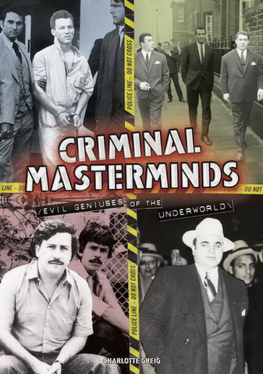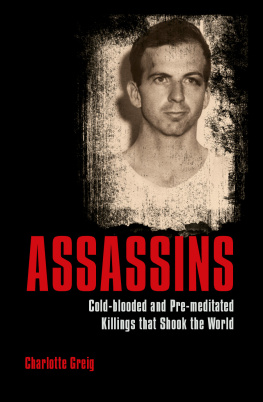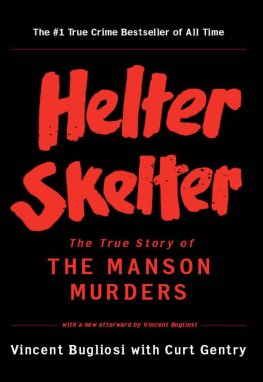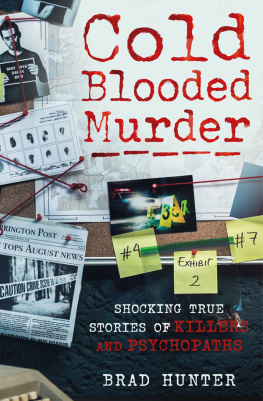COLD-BLOODED
KILLINGS
Hits, assassinations and near misses that shook the world
Charlotte Greig
Pictures reproduced with the permission of the following picture agencies: Corbis, Lebrecht, Rex. For more information please contact

This edition published in 2012 by Arcturus Publishing Limited
26/27 Bickels Yard,
151153 Bermondsey Street
London SE1 3HA
Copyright 2009 Arcturus Publishing Limited
All rights reserved. No part of this publication may be reproduced, stored in a retrieval system, or transmitted, in any form or by any means, electronic, mechanical, photocopying, recording or otherwise, without written permission in accordance with the provisions of the Copyright Act 1956 (as amended). Any person or persons who do any unauthorised act in relation to this publication may be liable to criminal prosecution and civil claims for damages.
ISBN: 978-1-84858-614-7
CONTENTS
INTRODUCTION
T hroughout history, assassinations of famous figures, whether major political leaders, powerful business people, or celebrities from the world of entertainment, have shocked onlookers, the media and the general public. These sudden, brutal killings have the dual purpose of murdering a well-known figure, thus putting an end to his or her influence, and also drawing attention to a political, religious, or social issue that may have been ignored or overlooked up to that point. Yet, as it transpires, a large number of assassinations are committed by people whose political affiliations are questionable; and in some cases, assassins have no political affiliations whatsoever.
What characterizes almost all of them, however, is an element of fanaticism. Many assassins are young men, often aged between eighteen and twenty-two, whose sense of mortality and caution is lacking; others are mentally unstable, often with a history of anti-social behaviour and consequent social exclusion; and yet others show signs of serious mental illness, to the point where their grasp of reality is so tenuous that they suffer from delusions, and they become extremely dangerous, violent individuals. Interestingly, there are very few instances where assassinations take place as a result of rational, pre-meditated plans on the part of political opponents. In most cases, even where the target is an oppressive ruler, assassinations appear to be committed in a random way, by people with disordered, impressionable minds, rather than being the outcome of carefully planned actions by ruthless, intelligent people determined to rid themselves of a political opponent.
Over the centuries, assassination has been used as a political weapon by pressure groups, often with far-reaching consequences that affect millions of people around the world. But there have also been many assassinations by lone individuals who are mentally unbalanced in some way. These have also, in many cases, had a profound effect on our lives, and cause us to reflect on the sanity of our modern-day society, in which security has become such a major issue.
The great assassinations
In this book, we look at the political assassinations that have shaped our history: for example, the assassination of Archduke Ferdinand on 28 June 1914, which heralded the outbreak of the First World War; the assassination of President John F. Kennedy on 22 November 1963, a date still etched in many peoples minds as they remember what they were doing when they first heard the news; and the assassination of Martin Luther King on 4 April 1968, whose murder had wide-ranging consequences for the progress of civil rights and race relations in the US and around the world. The assassination of other important world leaders, both contemporary and historical, is included too, from Julius Caesar to Mahatma Gandhi, from Patrice Lumumba to Yitzhak Rabin.
We also include the assassinations of maverick figures who achieved fame or notoriety in their times: those such as Rasputin, the drunken womanizer who became a friend to the Russian royal family, and who was believed to have magical powers; or Jean-Paul Marat, the bloodthirsty French revolutionary who made lists of those he wanted sent to the guillotine while he was in his bath, and who was brutally stabbed to death by a young radical, Charlotte Corday. In more recent times, there was flamboyant gay Dutch politician Pim Fortuyn, who was shot to death in a car park by a lone gunman. Then there are the chilling assassinations such as that of the ousted Bolshevik leader Leon Trotsky, who met his death with an ice pick embedded in his head; or Georgi Markov, the Bulgarian migr who was stabbed with a poisoned umbrella while walking on Waterloo Bridge, and who died in agony several days later.
Celebrity hitsand misses
In addition to these killings, we also deal with the assassinations of famous figures from the world of music, film and fashion, such as John Lennon and Gianni Versace. Often, the motives for these murders remain shadowy: they may be to do with the disturbed psychology of the assassin, who at once hero-worships and hates his idol; or there may be a web of circumstances underlying the murder that still, to this day, has not been fully investigated. Whatever the case, it seems that murders of celebrity figures are usually committed by people with extremely unbalanced minds, whose own frustrations and anxieties have reached a pitch where they are no longer in control of their actions with devastating consequences for their innocent victims. Certainly, it seems true to say that in our modern-day culture, the mere fact of being a celebrity makes one vulnerable to abuse from all kinds of mentally disturbed individuals, whether this abuse is harassment, stalking or in the worst case murder.
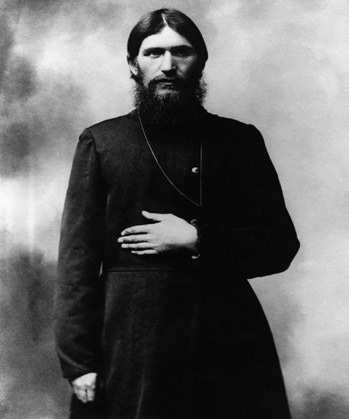
The mad monk of Romanov Russia, Rasputin was not easily assassinated. He was poisoned, shot and eventually drowned
Of course, the history of assassinations is not just one of hits. In this book, we also take a look at the assassinations that failed: the near misses, which are almost more fascinating than the hits. These are the attempted assassinations of political leaders like Adolf Hitler, Ronald Reagan, Charles de Gaulle and Margaret Thatcher, as well as cultural icons like Andy Warhol. What led to these crazed attempts? What stopped them? What would have happened if theyd pulled them off? And, most intriguingly, how did figures such as Reagan, de Gaulle, and Thatcher manage to remain so remarkably calm in the face of these attacks?
High drama
As well as discussing the implications of assassinations, we also go into detail as to the events themselves. Assassinations are, of course, usually highly dramatic events. Take the assassination of Julius Caesar, for instance, the Roman emperor who, at the height of his power, was stabbed to death in the Senate by a group of conspirators he thought were his friends and followers. Or that of Thomas Becket, the twelfth century archbishop and head of the British church who was stabbed to death by four heavily armed knights at Canterbury Cathedral as he stood on the steps of the altar, in full view of the congregation during a church service. Both these stories inspired many poets, writers and dramatists. In Shakespeares play, Julius Caesar , the emperor speaks the immortal lines, Et tu, Brute, on seeing the young man he believed to be his friend (or, as some believe, his son) coming forward to strike him. Today, Shakespeares saying is used to describe anger and dismay at the treachery of a friend. In the same way, the brutal slaying of Thomas Becket was dramatized by T.S. Eliot in Murder in the Cathedral , one of literatures most celebrated works.
Next page
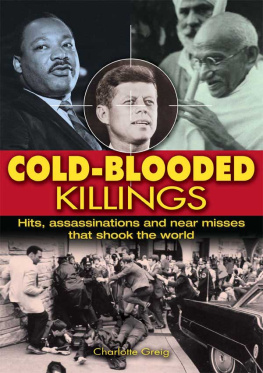
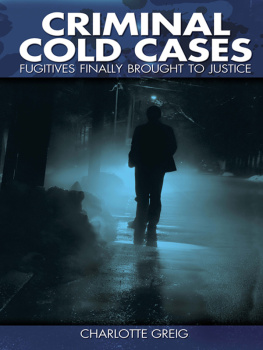
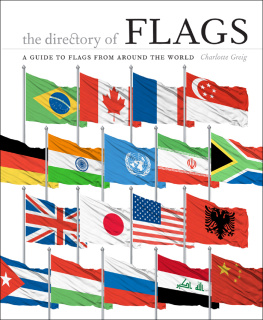
![Charlotte Greig - Evil Serial Killers. In the Minds of Monsters [Fully Illustrated]](/uploads/posts/book/70143/thumbs/charlotte-greig-evil-serial-killers-in-the-minds.jpg)
